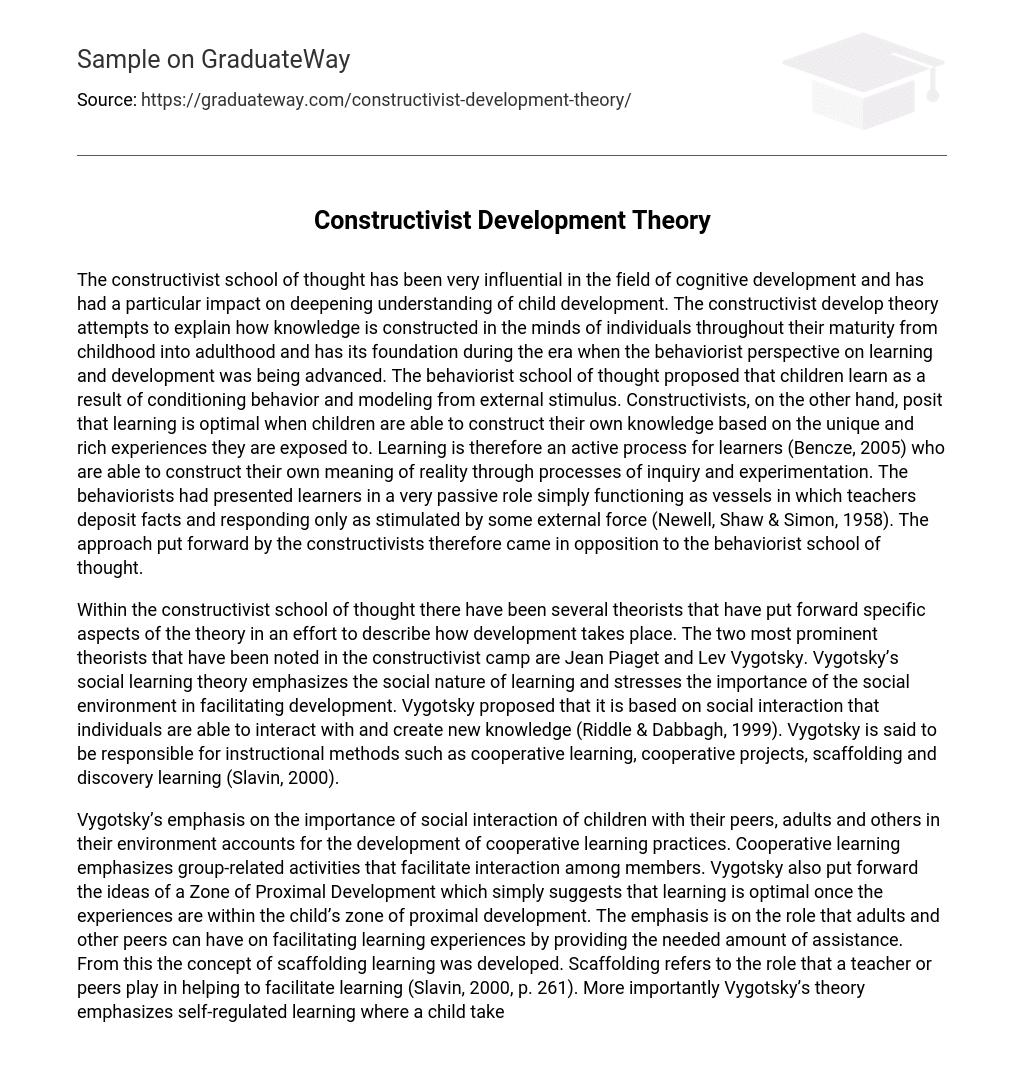The constructivist school of thought has been very influential in the field of cognitive development and has had a particular impact on deepening understanding of child development. The constructivist develop theory attempts to explain how knowledge is constructed in the minds of individuals throughout their maturity from childhood into adulthood and has its foundation during the era when the behaviorist perspective on learning and development was being advanced. The behaviorist school of thought proposed that children learn as a result of conditioning behavior and modeling from external stimulus. Constructivists, on the other hand, posit that learning is optimal when children are able to construct their own knowledge based on the unique and rich experiences they are exposed to. Learning is therefore an active process for learners (Bencze, 2005) who are able to construct their own meaning of reality through processes of inquiry and experimentation. The behaviorists had presented learners in a very passive role simply functioning as vessels in which teachers deposit facts and responding only as stimulated by some external force (Newell, Shaw & Simon, 1958). The approach put forward by the constructivists therefore came in opposition to the behaviorist school of thought.
Within the constructivist school of thought there have been several theorists that have put forward specific aspects of the theory in an effort to describe how development takes place. The two most prominent theorists that have been noted in the constructivist camp are Jean Piaget and Lev Vygotsky. Vygotsky’s social learning theory emphasizes the social nature of learning and stresses the importance of the social environment in facilitating development. Vygotsky proposed that it is based on social interaction that individuals are able to interact with and create new knowledge (Riddle & Dabbagh, 1999). Vygotsky is said to be responsible for instructional methods such as cooperative learning, cooperative projects, scaffolding and discovery learning (Slavin, 2000).
Vygotsky’s emphasis on the importance of social interaction of children with their peers, adults and others in their environment accounts for the development of cooperative learning practices. Cooperative learning emphasizes group-related activities that facilitate interaction among members. Vygotsky also put forward the ideas of a Zone of Proximal Development which simply suggests that learning is optimal once the experiences are within the child’s zone of proximal development. The emphasis is on the role that adults and other peers can have on facilitating learning experiences by providing the needed amount of assistance. From this the concept of scaffolding learning was developed. Scaffolding refers to the role that a teacher or peers play in helping to facilitate learning (Slavin, 2000, p. 261). More importantly Vygotsky’s theory emphasizes self-regulated learning where a child takes responsibility for their own cognitive development.
Piaget has also contributed important ideas to the development of constructivist theory. Piaget’s theory proposes that each child is actively involved in constructing his own reality. Piaget maintains that children are born with a naturally inquisitive nature, desiring to discover and interact with their environment. Reflexes form the foundation on which interaction and discovery is possible (Slavin, 2000, p. 33). Processes of adaptation, accommodation, assimilation and equilibration were also involved in development. From the earliest stage children develop schemes which are used to explore their environment. Adaptation, assimilation and accommodation take place when existing schemes are adjusted, or new schemes are developed as a consequence of their experiencing new situations. These processes facilitate the return to equilibrium where balance is restored between existing understanding and new experiences – the process of equilibration (Slavin, 2000).
Piaget believed that individuals pass through four different stages of. These stages are the sensorimotor (from 0 to 2 years), preoperational (from 2 to 7 years), concrete operational (from seven to eleven) and formal operational (from eleven to adulthood) periods. He also gives an estimate as to the age at which each child will enter either stage. Each child, Piaget argues, must pass through each of these stages of development in the specified order and no child can skip a particular stage.
Constructivism is a very useful way of examining how develop takes place. The strength of the theory is its focus on how experiences and elements in the social and physical environment are important in facilitating learning. An additional advantage is its position that constructing knowledge is basically an individual activity and that all that can be done by adults is to facilitate learning by providing experiences and material with which the child can interact in the process of constructing his own knowledge.
One weakness of the theory is that it suggests that knowledge is haphazard and that there are no set principles that can be passed on to children. By emphasizing the individual construction of knowledge constructivists are implying that each individual constructs their own concept of knowledge. However knowledge construction is not always possible and it is sometimes necessary to simply impart information. As this new information is passed on children are able to integrate these into their knowledge base. Another issue with constructivism is its position that learning is basically cognitively based. Behaviorists had proposed that learning must reflect a change in behavior and constructivists opposed this. Knowledge must, however, include cognitive, behavioral and attitudinal changes.
References
Bencze, J. L. (2005). Constructivist learning theory. Retrieved June 3, 2007, from http://leo.oise.utoronto.ca/~lbencze/Constructivism.html
Groome, D. (1999, July). (ed.). An Introduction to Cognitive Psychology: Processes and Disorders. (2nd ed.). U.K.: Psychology Press.
Newell, A., Shaw, J. C. & Simon, H. A. Elements of a theory of human problem solving. Psychological Review, 65(3), 1958.
Riddle, E. M. & Dabbagh, N. (1999, Mar 8). Lev Vygotsky’s social development theory. Retrieved June 3, 2007, from http://chd.gmu.edu/immersion/knowledgebase/theorists/constructivism/vygotsky.htm
Slavin, R. E. (2000). Educational Psychology: Theory and Practice. (6th ed.). Boston: Allyn and Bacon.





